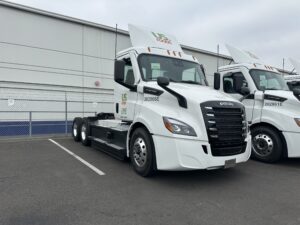
This 2026 Freightliner eCascadia VIN Verification was done by our team member in La Mirada, Ca. on 7-14-2025

This 2026 Freightliner eCascadia VIN Verification was done by our team member in La Mirada, Ca. on 7-14-2025
The 2026 Freightliner eCascadia is a cutting-edge all-electric Class 8 truck purpose-built for regional and short-haul operations. Based on the proven Cascadia platform, the eCascadia blends zero-emissions capability with the performance, comfort, and reliability that fleet operators have come to expect from Freightliner. Ideal for drayage, last-mile delivery, and dedicated route hauling, it enables commercial carriers to meet aggressive carbon reduction goals while improving fleet efficiency and uptime.
Freightliner began development of the eCascadia in the late 2010s in response to growing demand for electric freight vehicles and tightening emissions regulations in states like California. The truck was formally introduced in production form in 2022 and initially deployed in pilot fleets such as Penske, NFI, and Schneider. The 2026 model builds on several years of real-world fleet testing and feedback, offering enhanced range, shorter charging cycles, and a more refined driving experience. It represents Freightliner and Daimler Truck North America’s ongoing commitment to electrification, bolstered by the launch of the Detroit ePowertrain and dedicated eConsulting services for fleet transitions.
The 2026 eCascadia is available with several electric powertrain configurations, each designed to meet specific operational needs:
Detroit ePowertrain options:
Single eAxle (4×2):
Power: 320 or 395 horsepower
Torque: ~23,000 Nm (16,975 lb-ft) at the wheels (instant torque delivery)
Dual eAxle (6×4):
Power: 425 or 470 horsepower
Torque: Up to ~37,000 Nm at the wheels
Ideal for heavier regional hauls and short-haul freight
The ePowertrain integrates the motor(s), transmission, and electronics into a single unit for optimized efficiency. Its regenerative braking system not only extends range but also reduces brake wear, which contributes to lower long-term maintenance costs.
The eCascadia maintains the aerodynamic shape of the diesel Cascadia, but with design enhancements tailored for electric optimization:
Exterior:
Flush-mounted LED headlamps with optional heating elements
Closed grille and improved airflow management for reduced drag
MirrorCam (optional) for better aerodynamics and visibility
Signature blue badging and eCascadia decals
Interior:
Quiet cabin with reduced vibration due to lack of internal combustion
Optional 12-inch digital instrument display with configurable gauges
Ergonomic dash layout with EV-specific controls
Available sleeper cab options with rest bunks and climate zones
Interior build materials prioritize durability and comfort, making it ideal for drivers who spend extended hours on the road.
The 2026 eCascadia offers multiple configurations tailored to different operations:
Cab Types:
Day Cab – for short-haul and port drayage
Mid-Roof Sleeper – suited for regional overnight hauls
Raised-Roof Sleeper (60″ or 72″) – for fleet drivers on extended duty
Drivetrain Configurations:
4×2: Single axle, optimized for lighter urban delivery
6×4: Tandem axle, better suited for higher payloads or regional distribution
Customization options allow fleet buyers to spec features like tire pressure monitoring, electric HVAC, cab heaters, and trailer connectivity modules.
Safety remains a top priority in the eCascadia, equipped with the latest Detroit Assurance driver assistance systems:
Active Brake Assist 6 (ABA6): Pedestrian, vehicle, and cyclist detection
Lane Departure Protection: Warns and steers back into lane
Side Guard Assist: Monitors and warns about side blind spots
Adaptive Cruise Control with Stop-and-Go: Maintains safe distances in traffic
Electronic Parking Brake (ePark): Engages automatically and reduces rollback
Other key tech includes over-the-air software updates, a modular 24V electrical architecture, and fleet telematics integration through Detroit Connect.
Electric trucks don’t use fuel in the traditional sense, but the eCascadia delivers measurable efficiency gains:
Battery Packs:
291 kWh – Range ~155 miles
438 kWh – Range ~220–230 miles depending on configuration
Charging:
Max charge rate: 270 kW (via CCS1 or CCS2 combo connector)
0–80% charge in ~90 minutes (438 kWh battery)
Opportunity charging enables full-day operation with scheduled breaks
The regenerative braking system and onboard energy management software optimize battery usage and route planning.
The eCascadia competes primarily with:
Volvo VNR Electric
Tesla Semi
Kenworth T680E / Peterbilt 579EV
Nikola Tre BEV
While Tesla boasts longer theoretical range (500 miles), the Freightliner eCascadia is production-proven and backed by Daimler’s expansive dealer and service network. It leads in safety features and configurability and benefits from a broad array of parts compatibility with diesel Cascadias.
Pricing is not publicly listed but estimated between $350,000–$450,000, depending on configuration, battery size, and volume. Buyers may qualify for:
IRA tax credits (up to $40,000 per vehicle)
California HVIP and NYSERDA vouchers
EV infrastructure rebates for DC fast charging
Freightliner also offers leasing options and TCO (total cost of ownership) consultation services to aid electrification transitions.
EPA SmartWay Elite Certification (zero-emissions)
2023–2025 HDT Top 20 Product award recipient
Highly rated in North American Council for Freight Efficiency (NACFE) Run on Less – Electric reports
Recognized for helping major fleets (e.g., Sysco, Penske) reduce carbon output and operating costs
Need a VIN Verification? We are licensed to complete the REG 31 form. Call to get your car, truck or motorcycle verified today!
© 2025 QUICK VIN VERIFICATION. All rights reserved.